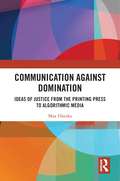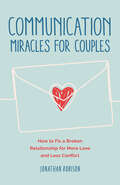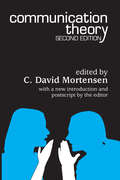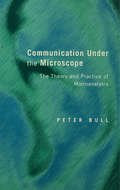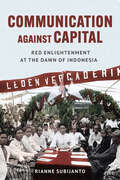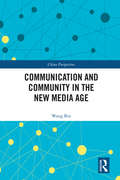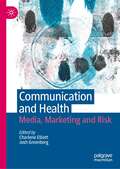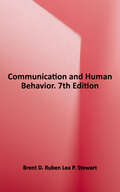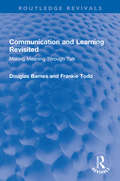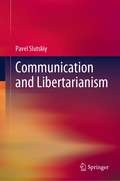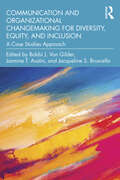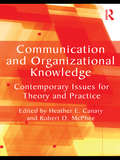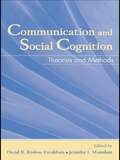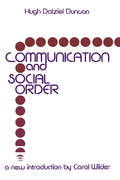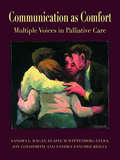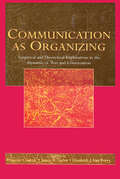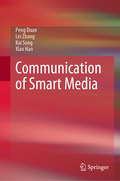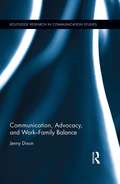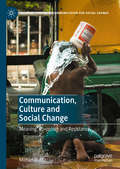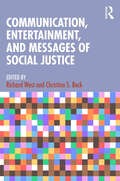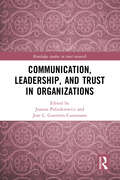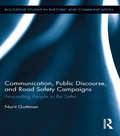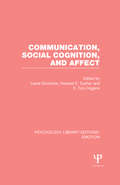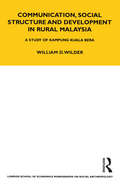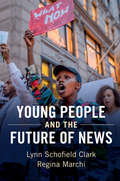- Table View
- List View
Communication Against Domination: Ideas of Justice from the Printing Press to Algorithmic Media
by Max HänskaThis book tackles the philosophical challenge of bridging the gap between empirical research into communication and information technology, and normative questions of justice and how we ought to communicate with each other. It brings the question of what justice demands of communication to the center of social science research. Max Hänska undertakes expansive philosophical analysis to locate the proper place of normativity in social science research, a looming subject in light of the sweeping roles of information technologies in our social world today. The book’s first section examines metatheoretical issues to provide a framework for normative analysis, while the second applies this framework to three technological epochs: broadcast communication, the Internet and networked communications, and the increasing integration of artificial intelligence and machine learning technologies into our communication systems. Hänska goes beyond the prevailing frameworks in the field by exploring how we answer normative questions and how our answer can change depending on our social context and the affordances of prevailing communications technologies. This book provides an essential guide for scholars as well as graduate and advanced undergraduate students of research and theory in communication, philosophy, political science, and the social sciences.
Communication Miracles for Couples: How to Fix a Broken Relationship for More Love and Less Conflict
by Jonathan RobinsonLearn How to Fix A Broken Relationship“The simplest, most practical and effective communication book for couples.” —Betty Eadie, author of Embraced by the Light and The Awakened Heart#1 Bestseller in Marriage & Family, Family Relationships, and DivorceCreate lasting harmony, healthy communication, and everlasting love with Jonathan Robinson's powerful couple communication book.Develop effective communication skills for a lasting relationship. The original Communication Miracles for Couples by bestselling author, psychotherapist, and one of Oprah's favorite relationship experts Jonathan Robinson has helped hundreds of thousands of couples repair their relationships with over 200,000 copies sold. Now updated, you can learn how to fix a broken relationship or simply strengthen your relationship using proven marriage therapy tools and techniques.Become one of those couples that work—period. This couple communication book is for couples who want to learn new skills and build a solid foundation for working through conflicts and moving forward in ways that strengthen their bonds. Learn how to enhance your relationship by learning to communicate with less blame and more understanding.Inside, you’ll find:Insightful tips to repair your marriageCouples communication skills to help you stop arguing, feel loved, and repair broken trust in your relationshipThe best at-home book for couples therapy, written by a trusted psychotherapistReaders of couple communication books like Relationship Goals, Alpha Female Bible, or More Love Less Conflict will love Communication Miracles for Couples.
Communication Theory
by C. David MortensenCommunication is the most complex and elevating achievement of human beings. Most people spend up to 70 percent of our waking hours engaged in some form of communication. Listening and responding to the messages of others occupies much of this time; the rest is taken up by talking, reading, and writing. An additional consideration is the rich assortment of nonverbal cues humans share, which also constitute a form of communication. All together, the stream of verbal and nonverbal information that bombards our senses is composed of as many as 2,000 distinguishable units of interaction in a single day. The kinds of interaction change constantly: morning greetings, cereal labels, bus signs, charts, traffic lights, hate stares, graffiti, coffee shop chat, gestures, laughter, and head nods: The themes are endless. All of this constitutes subject matter for the study of communication.The book seeks to acquaint students with a basic understanding of the process of human communication. The breadth and scope of subject matter is adaptable to a number of approaches to the first course in communication, whether theoretical, practical, contemporary, or traditional in orientation.The framework of this book introduces five topics of central interest to the field of communication theory. Part I describes the process of communication as it unfolds in face-to-face environments. Part II considers the symbolic significance of interpersonal behavior. Part III examines the organization of communicative acts and shows why human interactions tend to become more synchronous over time. Part IV explores the complex problem of understanding other people, demonstrating the tendency of understanding to become intersubjective. Part V accounts for the communicative significance of several basic human environments--communities, organizations, media, institutions, and culture.
Communication Under the Microscope: The Theory and Practice of Microanalysis
by Peter BullSocial interaction in recent years has become the focus of systematic scientific research in a wide variety of academic disciplines. In Communication under the Microscope, Peter Bull shows how communication has become an object of study in its own right, which can be dissected in the finest detail through the use of film and recording technology. In so doing he provides a clear and valuable introduction into the theory and practice of microanalysis.Bull argues that microanalysis is both a distinctive methodology and a distinctive way of thinking about communication. He then focuses on the two principal elements of face-to-face communication: speech and non-verbal behaviour. Communication in particular social contexts is also addressed with related chapters on gender and politics. Finally, the practical aspects of microanalysis are discussed.This unique and thorough review of microanalysis integrates different approaches and draws together research literature which is often diverse and disparate. Presented in a clear and focused style, this book will be of interest to psychologists, social scientists and all students and researchers in the field of communication.Communication is central to many aspects of human life, yet it has only recently become the focus of systematic scientific investigation within a wide variety of academic disciplines. Communication has now become an object of study in its own right, and can be dissected in the finest detail with the use of recording technology (film, audiotape and videotape). This approach has become known as 'microanalysis', and forms the principal theme of Communication under the Microscope.
Communication against Capital: Red Enlightenment at the Dawn of Indonesia (Cornell Modern Indonesia Project)
by Rianne SubijantoCommunication against Capital explores the revolutionary communication strategies of the pergerakan merah, the anticolonial "red movement" in 1920s Indonesia. Rianne Subijanto tells the story of ordinary lower-class women and children and people of diverse races and ethnicities who waged their battles against Dutch colonialism within multiple arenas of communication, including political associations, assemblies, printed matter, schools, and shipping lines. Existing communication technologies were repurposed into mechanisms of struggle and used as weapons in anticolonial and anticapitalist resistance. In this process, communist ideas merged with ideals drawn from the Enlightenment to shape the emancipatory spirit of Indonesians. This red enlightenment motivated the production of revolutionary communication strategies of mobilization. Subijanto's innovative work shows that the novel techniques of the pergerakan merah served to shift anticolonial mobilization in Indonesia from warfare to modern forms of communication.
Communication and Community in the New Media Age (China Perspectives)
by Wang BinThis book investigates the relationship between information communication and community development in China in the new media age, drawing on theoretical resources from journalism, communication, urban sociology, community management, and the activities of social movements. Contrasting existing scholarship that centers on new technologies and virtual aspects of today’s communication, the study highlights community residents’ daily praxis in real social spaces and the interaction between online and offline communications. Through content analysis, case studies, questionnaire surveys, and in-depth interviews, the author explores the social engagement of communication in public expressions and negotiations among Chinese urban communities. From micro, meso and macro levels respectively, three interactive mechanisms are discussed: (1) media use and social consciousness and mobilization; (2) new media and changes in community governance; and (3) state-community interplay. Based on these mechanisms, the author proposes the idea of “the construction of grassroots social communication”, exploring approaches to the modernization of social governance and attainment of social interests by optimizing information communication. Communication and Community in the New Media Age will appeal to academics and students studying communication and social transition in China, new media and society, urban sociology, and public governance.
Communication and Health: Media, Marketing and Risk
by Charlene Elliott Josh GreenbergThis book explores the unique contribution that critical communication studies can bring to our understanding of health. It covers several broad themes: representing and mediating health; marketing and promoting health, co-producing health; and managing health crises and risks. Chapters speak to moral and social regulation through health communication, technologies of health, healthism and governmentality. They engage with historical and contemporary issues, offering readers theoretically grounded perspectives. At base, the book explores what a critical communication approach to health might look like, revealing in important—and sometimes surprising—ways how communication sits at the centre of understanding how health is constructed, contested, and made meaningful.
Communication and Human Behavior
by Brent D. Ruben Lea StewartA knowledge of human behavior helps us understand ourselves, our actions, our motives, our feelings, and our aspirations… <p><p> Communication and Human Behavior portrays a broad and colorful landscape of the field, outlines the history of communication study, and focuses on communication as a basic life process that is necessary to our lives as individuals and to our relationships, groups, organizations, cultures, and societies. <p><p> Communication and Human Behavior by Brent Ruben and Lea Stewart: <p> • integrates up-to-date examples and research findings throughout, including persuasion, interpersonal relationships, organizational communication and leadership, 21st century careers, useful information about Middle Eastern culture, contemporary social media use, and more. <p> • examines the role of communication in multiple contexts of human life, including individual relationships, groups, organizations, cultural/intercultural frameworks, and public and mass communication. <p> • is expansive yet integrated, rigorous yet readable, and fuses theory and practice.
Communication and Learning Revisited: Making Meaning Through Talk (Routledge Revivals)
by Frankie Todd Douglas BarnesFirst published in 1995, Communication and Learning Revisited focuses on the importance and benefits of group dialogue in cooperative learning. The book explores the use of group dialogue among students across a variety of disciplines and demonstrates how collaboration helps them to understand different concepts. It outlines cognitive and social strategies that can enhance collaboration and presents collaborative talk’s role in learning, setting forth a theoretical framework that draws upon the ideas of writers such as Vygotsky and Bakhtin. Communication and Learning Revisited will appeal to those with an interest in teaching methods, classroom dialogue, and cooperative learning.
Communication and Libertarianism
by Pavel Slutskiy"This is an outstanding contribution to both libertarian political philosophy and communication theory. It is far and away the most comprehensive work on communication issues in libertarian theory ever published. The author has integrated successfully the libertarian insights of Mises, Rothbard, Block, Kinsella and others with the philosophy of language as developed by Austin, Searle and Grice. He has done so in a unique and unprecedented way. The book would appeal to students and scholars interested in libertarian theory and more generally, to philosophers and political scientists interested in high-level scholarship.” - David Gordon, libertarian philosopher and intellectual historian, Ludwig von Mises Institute.
Communication and Organizational Changemaking for Diversity, Equity, and Inclusion: A Case Studies Approach
by Van Gilder, Bobbi J. Jasmine T. Austin Jacqueline S. BruscellaThis book explores the opportunities, challenges, and effective approaches to organizational change regarding diversity, equity, inclusion, and belonging. Featuring application-based case studies and practical guidelines for meaningful organizational change, this book problematizes some of the current DEI initiatives in today’s organizations. It examines multiple forms of diversity (e.g., race, age, and mental health) from a variety of perspectives (e.g., leadership and employee), with case studies that demonstrate how changemaking efforts can be reimagined and implemented in better, more nuanced, and more sustainable ways to produce meaningful organizational change. Through these case studies, readers learn from organizations’ successes and failures in their attempts to implement DEI practices. Each chapter concludes with explicit practical implications and/or actionable recommendations for organizational changemaking. This text will make an impactful addition to courses in communication and diversity or organizational communication/change at the advanced undergraduate or graduate level, and will be an essential guide for professionals wishing to lead change in their organizations.
Communication and Organizational Knowledge: Contemporary Issues for Theory and Practice (Routledge Communication Series)
by Heather E. CanaryThis book provides an overview of communication-centered theory and research regarding organizational knowledge and learning. It brings the work of scholars in communication, management, information technology, and other disciplines together in a coherent volume that represents existing research and theory on communication-related knowledge work. Chapters address what constitutes knowledge, how knowledge functions within and across organizations, and how organizational members develop and manage knowledge for organizational purposes. The book also provides a forum for these scholars to pose directions for future research and theorizing. It will serve as a reference tool for scholars and practitioners to identify and understand communicative features of organizational knowledge processes.
Communication and Social Cognition: Theories and Methods (Routledge Communication Series)
by David R. Roskos-Ewoldsen Jennifer L. MonahanCommunication and Social Cognition represents the explosion of work in the field of social cognition over the past 25 years. Expanding the contribution made by Social Cognition and Communication, published in 1982, this scholarly collection updates the study of communication from a social cognitive perspective, with contributions from well-known experts and promising new scholars in diverse areas of communication. Organized into sections--message production, interpersonal communication, media, and social influence--the collection reflects the areas in which social cognition theories have become integral in understanding communicative processes, and in which a proliferation of scholarship has emerged. Readers are informed of the current major trends in social cognition research, and are introduced to its history. Throughout the text, chapter authors highlight both theoretical and methodological aspects of research, encouraging communication scholars to include social cognition in their research, and, likewise, promoting communication to social cognition researchers. The volume addresses the future of social cognition, including the most fitting directions in which to take scholarship, emerging theories in the field, and the methods currently yielding the most promising results. Communication and Social Cognition appeals to scholars, researchers, and advanced students in communication and psychology. It can be used as a textbook in graduate courses related to social cognition, social influence, message production, interpersonal communication, media effects, and message design.
Communication and Social Order
by Hugh Dalziel DuncanIn this highly influential study of art forms as models for a theory of communications, Hugh Dalziel Duncan demonstrates that without understanding of the role of symbols in society, social scientists cannot hope to develop adequate models for social analysis. He reviews critically major contributions to communication theory during the past century: Freud's analysis of dream symbolism, Simmel's concept of sociability, James' insights into religious experience, and Dewey's relating of art to experience.
Communication as Comfort: Multiple Voices in Palliative Care (Routledge Communication Series)
by Sandra L. Ragan Elaine M. Wittenberg-Lyles Joy Goldsmith Sandra Sanchez ReillyThis exceptional work explores the complexities of communication at one of the most critical stages of the life experience--during advanced, serious illness and at the end of life. Challenging the predominantly biomedical model that informs much communication between seriously ill and/or dying patients and their physicians, caregivers, and families, Sandra L. Ragan, Elaine M. Wittenberg-Lyles, Joy Goldsmith, and Sandra Sanchez-Reilly pose palliative care--medical care designed to comfort rather than to cure patients--as an antidote to the experience of most Americans at the most vulnerable juncture of their lives. With an author team comprised of three health communication scholars and one physician certified in geriatrics and palliative medicine, this volume integrates the medical literature on palliative care with that of health communication researchers who advocate a biopsychosocial approach to health care. Applying communication theories and insights to illuminate problems and to explain their complexities, the authors advocate a patient-centered approach to care that recognizes and seeks to lessen patients’ suffering and the many types of pain they may experience (physical, psychological, social, and spiritual) during life-threatening illness.
Communication as Organizing: Empirical and Theoretical Explorations in the Dynamic of Text and Conversation (Routledge Communication Series)
by James R. Taylor Elizabeth J. Van Every François CoorenCommunication as Organizing unites multiple reflections on the role of language under a single rubric: the organizing role of communication. Stemming from Jim Taylor's earlier work, The Emergent Organization: Communication as Its Site and Surface (LEA, 2000), the volume editors present a communicational answer to the question, "what is an organization?" through contributions from an international set of scholars and researchers. The chapter authors synthesize various lines of research on constituting organizations through communication, describing their explorations of the relation between language, human practice, and the constitution of organizational forms. Each chapter develops a dimension of the central theme, showing how such concepts as agency, identity, sensemaking, narrative and account may be put to work in discursive analysis to develop effective research into organizing processes. The contributions employ concrete examples to show how the theoretical concepts can be employed to develop effective research. This distinctive volume encourages readers to discover and develop a truly communicational means of addressing the question of organization, addressing how organization itself emerges in the course of communicational transactions. In presenting a single and entirely communicational perspective for exploring organizational phenomena, grounded in the discourse of communicational transactions and the establishment of relationships through language, it is required reading for scholars, researchers, and graduate students working in organizational communication, management, social psychology, pragmatics of language, and organizational studies.
Communication of Smart Media
by Lei Zhang Peng Duan Kai Song Xiao HanThis book provides the readers with an interdisciplinary perspective on communication in the diffuse boundaries that also demonstrates the diversity and inclusion for presenting wide range and rapid changes in contents, and the authors use “smart” as the guiding principle while indicate “communication” has been defined as a core feature. Appropriately, the book is divided into eight major sections. As always, the inevitable result of upgrading and constant iterations of developing new communication technology, the media communication has turned out to be one of the most important means in the smart era. The book sheds new light on virtual reality (VR), a pioneering technology in smart media communication, as an entry point to explore why the core social networks of smart news and smart media communication could occupy the central position in smart media communication while to discuss issues such as platform society built using smart media communication, and further elaborate on the integration of 5G technology, media and social transformation. This book not merely covers disciplines such as journalism and communication, but also on the universal application of smart media communication, and furthermore, it provides practical guidance and reviews cutting-edge ideas. It serves as a good future reference to help scholars, graduate students as well as relevant professionals for thinking outside the box that in order to continually expand reader’s knowledge and professional capabilities, especially aware of the impact of observation and judgment, value analysis and lifelong learning.
Communication, Advocacy, and Work/Family Balance (Routledge Research in Communication Studies)
by Jenny DixonThis book presents an understanding of work-family balance for working adults belonging to a number of different family structures (e.g. single and/or childfree adults, LGBT couples, families with female breadwinners). It contends that family structure should serve as a way of thinking about diversity (i.e., race, gender, age, family) in the U.S. workplace. It also argues that—in addition to accommodations occurring through workplace policy—the negotiation of work-family balance happens as a result of self-advocacy that occurs in everyday communication about family at work. Relaying the stories of a number of different working adults belonging to a variety of different family structures, it explores the range of obstacles faced in the attempt at balancing work and family life, generates informed ideas for eliminating barriers commonly experienced in balancing work and family, and problematizes enduring assumptions regarding gender roles and the myth of steadfast public and private spheres.
Communication, Culture and Social Change: Meaning, Co-option and Resistance (Palgrave Studies in Communication for Social Change)
by Mohan DuttaDrawing on the culture-centered approach (CCA), this book re-imagines culture as a site for resisting the neocolonial framework of neoliberal governmentality. Culture emerged in the 20th Century as a conceptual tool for resisting the hegemony of West-centric interventions in development, disrupting the assumptions that form the basis of development. This turn to culture offered radical possibilities for decolonizing social change but in response, necolonial development institutions incorporated culture into their strategic framework while simultaneously deploying political and economic power to silence transformative threads. This rise of “culture as development” corresponded with the global rise of neo-liberal governmentality, incorporating culture as a tool for globally reproducing the logic of capital. Using examples of transformative social change interventions, this book emphasizes the role of culture as a site for resisting capitalism and imagining rights-based, sustainable and socialist futures. In particular, it attends to culture as the basis for socialist organizing in activist and party politics. In doing so, Culture, Participation and Social Change offers a framework of inter-linkage between Marxist analyses of capital and cultural analyses of colonialism. It concludes with an anti-colonial framework that re-imagines the academe as a site of activist interventions.
Communication, Entertainment, and Messages of Social Justice
by Richard West Christina S. BeckThis edited collection explores the contemporary interplay among three pivotal areas found in cultures around the world: communication, entertainment, and messages of social justice. Each chapter centralizes communication as instrumental in creating mediated messages pertaining to social justice, usually resulting in a more educated audience.Using an accessible writing style, the contributors investigate both classic and contemporary social media, television, film, stage, radio, and podcast productions by employing both qualitative and quantitative methods. Furthermore, through case studies on topics including transphobia, indigenous comedy and drag performance, this book assesses key issues and themes portrayed in contemporary entertainment education. It provides a foundational framework for analysis by utilizing a broad range of theoretical models to explore representations of race, class, gender, advocacy, and pedagogy among others as well as their communication implications.This book will be of interest to scholars and students in the fields of Communication Studies, Popular Culture Studies, Media Studies, Theatre Studies, Social Justice Studies, Sociology, and Psychology.
Communication, Leadership and Trust in Organizations (Routledge Studies in Trust Research)
by Joanna Paliszkiewicz Cusumano, Jose L. GuerreroTrust in communication and leadership is the key to success in business. This book presents and discusses the main issues and challenges posed by communication, leadership, and trust. The first part of the book describes the communication and trust issues, the second part presents the role of trust in leadership, and the third part describes different examples of implementing trust to organizations. Readers will gain from this book theoretical and practical knowledge of communication, leadership, and trust; empirically validated practice regarding trust and its related concepts; and a novel approach for addressing this topic. This book can be used as a toolbox to improve understanding and opportunities related to building trust in organizations and will be especially valuable for students and researchers in the fields of leadership, organizational communication, business ethics, and trust research.
Communication, Public Discourse, and Road Safety Campaigns: Persuading People to Be Safer (Routledge Studies in Rhetoric and Communication)
by Nurit GuttmanThis book discusses the use of communication campaigns to promote road safety, arguing that they need to elicit public discourse on issues pertaining to culture, equity, gender, workplace norms, environmental issues, and social solidarity. Increasingly, new media channels and formats are employed in the dissemination process, making road safety-related messages ubiquitous, and often controversial. Policy makers, educators, researchers, and the public continue to debate the utility and morality of some of the influence tactics employed in these messages, such as the use of graphic images of injury or death, stigmatization (or "blame and shame"), and the use of "black humor." Guttman argues that influencing road safety requires making changes in normative and cultural conceptions of broader issues in society, yet the typical discourse on road safety tends to focus on individual attitudes and practices. The book highlights the importance of social and behavioral theory in communication campaigns on road safety, and critiques the tendency to focus on individual cognition, affect, and risk conceptions rather than on normative, structural, and cultural factors. The volume positions the discourse on road safety as a social issue, and treats road safety behavior as a social activity that directly relates to other public issues, social values, and social policy, while discussing potential uses of social media and participatory approaches. The discussion turns to the role of road safety communication campaigns as part of a democratic process of eliciting public discourse, including how contemporary society could address broader issues of risk and safety.
Communication, Social Cognition, and Affect (Psychology Library Editions: Emotion)
by E. Tory Higgins Lewis Donohew Howard E. SypherOriginally published in 1988, the purpose of this book was to explore the interrelations among communication, social cognition and affect. The contributors, selected by the editors, were some of the best known in their fields and they significantly added to the knowledge of this interdisciplinary domain at the time. In late April 1986 the authors met at a conference centre at the University of Kentucky. They presented first drafts of their chapters and exchanged ideas. Out of these interactions came this book, which has a broad interest across several areas of psychology and communication. While answering a number of questions, the authors also posed others for future examination.
Communication, Social Structure and Development in Rural Malaysia: A Study of Kampung Kuala Bera
by William WilderThis is an important innovative analysis of communication and society in Pahang, West Malaysia, based on fieldwork carried out in Kampung Kuala Bera. Dr Wilder is concerned with communication networks of all kinds as found in a long-established Malay village, including the uses of language, small-scale (kinship and village-based) networks, and higher-level systems (the district and the nation as a whole). Dr Wilder lays particular emphasis on the role of communication in the process of economic development and on administration during a period of rapid and induced social change. His study is prefaced by a detailed historical account of Pahang and a thorough sociological analysis of Kampung Kuala Bera. The ethnography is meticulously detailed; its special contribution includes the first-ever publication of a Malay village genealogy, a systematic account of birth-order names (a major feature of the kinship system), complete figures on marital breakdowns for the whole village population, and an intensive analysis of leadership in its local context. This work will be of value to students of Southeast Asian societies, rural sociology, network studies, economic development, political education and the mass media in third world countries.
Communication, Society and Politics: Social Media and the Rise of Connective Journalism (Communication, Society and Politics)
by Lynn Schofield ClarkYoung People and the Future of News traces the practices that are evolving as young people come to see news increasingly as something shared via social networks and social media rather than produced and circulated solely by professional news organizations. The book introduces the concept of connective journalism, clarifying the role of creating and sharing stories online as a key precursor to collective and connective political action. At the center of the story are high school students from low-income minority and immigrant communities who often feel underserved or misrepresented by mainstream media but express a strong interest in politics and their communities. Drawing on in-depth field work in three major urban areas over the course of ten years, Young People and the Future of News sheds light on how young people share news that they think others should know about, express solidarity, and bring into being new publics and counter-publics.
